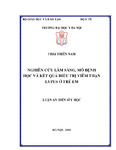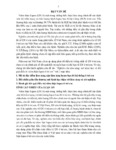
Please use this identifier to cite or link to this item:
http://dulieuso.hmu.edu.vn/handle/hmu/1778| Title: | Nghiên cứu lâm sàng, mô bệnh học và kết quả điều trị viêm thận lupus ở trẻ em |
| Authors: | Thái Thiên, Nam |
| Advisor: | GS.TS. Lê Thanh, Hải PGS.TS. Trần Văn, Hợp |
| Keywords: | 62720135;Nhi khoa |
| Issue Date: | 2018 |
| Abstract: | . THÔNG TIN TÓM TẮT NHỮNG KẾT LUẬN MỚI . CỦA LUẬN ÁN TIẾN SĨ. Tên đề tài: “Nghiên cứu lâm sàng, mô bệnh học và kết quả điều trị viêm thận lupus ở trẻ em”. Mã số: 62720135; Chuyên ngành: Nhi khoa. Nghiên cứu sinh: Thái Thiên Nam; Khóa 29. Người hướng dẫn: 1. GS.TS.Lê Thanh Hải; 2. PGS.TS. Trần Văn Hợp. Cơ sở đào tạo: Trường Đại học Y Hà Nội. Những kết luận mới của luận án: . Nghiên cứu trên 126 trẻ em bị viêm thận lupus cho thấy: Tuổi trung bình khởi phát bệnh 11,2 tuổi; 110 nữ và 16 nam. 4 dấu hiệu thường gặp là tổn thương da (ban cánh bướm, tăng nhạy cảm ánh sáng), niêm mạc (loét miệng lợi), đau/viêm khớp, biểu hiện thần kinh tâm thần. Bệnh cảnh lâm sàng chủ yếu trong viêm thận lupus: Hội chứng viêm thận cấp, hội chứng thận hư kết hợp, suy thận. Biến đổi miễn dịch thường gặp là giảm bổ thể C3, C4; tỉ lệ kháng thể kháng nhân và anti-dsDNA dương tính chiếm tỷ lệ rất cao (>80%).. Tổn thương mô bệnh học thận thường gặp nhất là lớp IV chiếm tỷ lệ 44,4%, tiếp theo lớp III (31%), lớp II là 15,1%. Lớp IV thường có hội chứng thận hư (kết hợp), suy thận, đặc biệt suy thận vừa và nặng, protein niệu khoảng thận hư, bổ thể C4 thấp, chỉ số hoạt động cao và thường có liềm tế bào, fullhouse. Lớp V biểu hiện lâm sàng đa dạng, không suy thận, protein niệu khoảng thận hư, giảm albumin máu <25g/L nhưng bổ thể C4 bình thường, không tăng Anti-DsDNA. Lũy tích khả năng hồi phục hoàn toàn theo thời gian đánh giá đạt 75% sau 24 tháng và lên đến >95% sau 36 tháng. Lớp tăng sinh, đặc biệt lớp IV có thời gian hồi phục hoàn toàn chậm hơn so với các lớp khác. Suy thận mạn chiếm tỷ lệ rất thấp từ 1-3%. Chỉ có một trường hợp tử vong vào trong kỳ đánh giá 6 tháng. Tần suất tái phát là 0,32 đợt/bệnh nhân/năm. Tổng số đợt nhiễm khuẫn/BN/năm cao nhất là thời điểm 6 tháng (1,6 đợt/bệnh nhân/năm). Tác dụng phụ của thuốc thường gặp trong 6 tháng đầu. Chỉ số tổn thương mạn tính SLICC/ACR sau 12 tháng đạt tỷ lệ thấp, tuy nhiên thời gian theo dõi càng dài thì tỷ lệ tổn thương mạn tính càng tăng lên 16,7% (sau 4 năm). Yếu tố tiên lượng xấu: Hội chứng thận hư, protein niệu ngưỡng thận hư, tái phát, chỉ số tổn thương mạn tính SLICC/ACR cao và mô bệnh học lớp IV. NGƯỜI HƯỚNG DẪN GS.TS. Lê Thanh Hải NGHIÊN CỨU SINH Thái Thiên Nam . . SUMMARY OF DOCTORAL THESIS’S NEW CONCLUSIONS. Tên đề tài: "Study of clinical, histopathological and treatment outcomes of lupus nephritis in children". Code: 62720135; Specialty: Pediatrics. Fellow: Thai Thien Nam; Course: 29. Supervisor: Professor Le Thanh Hai, MD., PhD; Associate Professor: Tran Van Hop, MD., PhD.. Institution: Hanoi Medical University.. New conclusions of the thesis:. - Our search identified 126 children with lupus nephritis, the mean age at onset of SLE was 11.2 years; female to male: 7/1.. - 4 common clinical signs are: skin lesions (Malar rash, photosensitivity), oral ulcers, arthritis and psychosis. Common renal symptoms: nephritis, nephritis/nephrotic syndrome and acute renal failure.. - Serological test is decreased C3, C4 level (>90%); ANA and anti-dsDNA positive is very high (> 85%).. - Renal biopsy revealed ISN/RPS class IV, III, II and V nephritis in 56 (44.4%), 39 (31%), 19 (15.1%) and 9 (7.1%). Clinico-histopathology: class IV nephtitis usually has nephron-nephtitis syndrome, moderate to severe renal failure, kidney failure, nephrotic proteinuria, low C4 level, High activity index and crescent; Class V nephtitis showed normal kidney function, nephrotic proteinuria, albuminemia <25g / L but normal C4 level, normal anti-DsDNA level.. - The actuarial patient survival rates at 24 , 36 and 72 months of age were 75%, 96% and 96%, respectivity. The proliferative class nephritis, especially class IV nephritis has a slower recovery time than other classes.. - Chronic renal disease accounts for a very low rate of 1-3%. There was only one death in the 6-month evaluation period. The recurrence rate was 0.32 times/patient/year. The infection rates is highest at the first 6 months (1.6 times/patients/year). Side effects of the drug are common in the first 6 months.. - SLICC/ACR were low at 12 months, but the longer the follow-up period, the higher the SLICC/ACR was attended and increased to 16.7% at 4 years of follow-up time.. - Poor prognostic factors: nephrotic syndrome, nephrotic proteinuria, moderate and severe renal failure, high SLICC/ACR and class IV nephritis SUPERVISOR Le Thanh Hai FELLOW Thai Thien Nam . |
| URI: | http://dulieuso.hmu.edu.vn//handle/hmu/1778 |
| Appears in Collections: | Luận án (nghiên cứu sinh) |
Files in This Item:
| File | Description | Size | Format | |
|---|---|---|---|---|
| 326_THAITHIENNAM-LA.pdf Restricted Access | 2.13 MB | Adobe PDF |  Sign in to read | |
| 326_ThaiThienNam-tt.pdf Restricted Access | 641.32 kB | Adobe PDF |  Sign in to read |
Items in DSpace are protected by copyright, with all rights reserved, unless otherwise indicated.